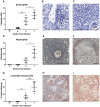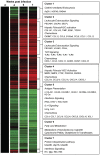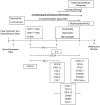Temporal expression of chemokines dictates the hepatic inflammatory infiltrate in a murine model of schistosomiasis
- PMID: 20161726
- PMCID: PMC2817718
- DOI: 10.1371/journal.pntd.0000598
Temporal expression of chemokines dictates the hepatic inflammatory infiltrate in a murine model of schistosomiasis
Abstract
Schistosomiasis continues to be an important cause of parasitic morbidity and mortality world-wide. Determining the molecular mechanisms regulating the development of granulomas and fibrosis will be essential for understanding how schistosome antigens interact with the host environment. We report here the first whole genome microarray analysis of the murine liver during the progression of Schistosoma japonicum egg-induced granuloma formation and hepatic fibrosis. Our results reveal a distinct temporal relationship between the expression of chemokine subsets and the recruitment of cells to the infected liver. Genes up-regulated earlier in the response included T- and B-cell chemoattractants, reflecting the early recruitment of these cells illustrated by flow cytometry. The later phases of the response corresponded with peak recruitment of eosinophils, neutrophils, macrophages and myofibroblasts/hepatic stellate cells (HSCs) and the expression of chemokines with activity for these cells including CCL11 (eotaxin 1), members of the Monocyte-chemoattractant protein family (CCL7, CCL8, CCL12) and the Hepatic Stellate Cell/Fibrocyte chemoattractant CXCL1. Peak expression of macrophage chemoattractants (CCL6, CXCL14) and markers of alternatively activated macrophages (e.g. Retnla) during this later phase provides further evidence of a role for these cells in schistosome-induced pathology. Additionally, we demonstrate that CCL7 immunolocalises to the fibrotic zone of granulomas. Furthermore, striking up-regulation of neutrophil markers and the localisation of neutrophils and the neutrophil chemokine S100A8 to fibrotic areas suggest the involvement of neutrophils in S. japonicum-induced hepatic fibrosis. These results further our understanding of the immunopathogenic and, especially, chemokine signalling pathways that regulate the development of S. japonicum-induced granulomas and fibrosis and may provide correlative insight into the pathogenesis of other chronic inflammatory diseases of the liver where fibrosis is a common feature.
Conflict of interest statement
The authors have declared that no competing interests exist.
Figures






Similar articles
-
Gene profile of chemokines on hepatic stellate cells of schistosome-infected mice and antifibrotic roles of CXCL9/10 on liver non-parenchymal cells.PLoS One. 2012;7(8):e42490. doi: 10.1371/journal.pone.0042490. Epub 2012 Aug 8. PLoS One. 2012. PMID: 22905138 Free PMC article.
-
Co-ordinated gene expression in the liver and spleen during Schistosoma japonicum infection regulates cell migration.PLoS Negl Trop Dis. 2010 May 18;4(5):e686. doi: 10.1371/journal.pntd.0000686. PLoS Negl Trop Dis. 2010. PMID: 20502518 Free PMC article.
-
Cellular and chemokine-mediated regulation in schistosome-induced hepatic pathology.Trends Parasitol. 2014 Mar;30(3):141-50. doi: 10.1016/j.pt.2013.12.009. Epub 2014 Jan 13. Trends Parasitol. 2014. PMID: 24433721 Review.
-
Schistosome egg antigen stimulates the secretion of miR-33-carrying extracellular vesicles from macrophages to promote hepatic stellate cell activation and liver fibrosis in schistosomiasis.PLoS Negl Trop Dis. 2023 May 30;17(5):e0011385. doi: 10.1371/journal.pntd.0011385. eCollection 2023 May. PLoS Negl Trop Dis. 2023. PMID: 37253066 Free PMC article.
-
T Lymphocyte-Mediated Liver Immunopathology of Schistosomiasis.Front Immunol. 2020 Feb 18;11:61. doi: 10.3389/fimmu.2020.00061. eCollection 2020. Front Immunol. 2020. PMID: 32132991 Free PMC article. Review.
Cited by
-
Gene profile of chemokines on hepatic stellate cells of schistosome-infected mice and antifibrotic roles of CXCL9/10 on liver non-parenchymal cells.PLoS One. 2012;7(8):e42490. doi: 10.1371/journal.pone.0042490. Epub 2012 Aug 8. PLoS One. 2012. PMID: 22905138 Free PMC article.
-
Real-time PCR demonstrates high prevalence of Schistosoma japonicum in the Philippines: implications for surveillance and control.PLoS Negl Trop Dis. 2015 Jan 21;9(1):e0003483. doi: 10.1371/journal.pntd.0003483. eCollection 2015 Jan. PLoS Negl Trop Dis. 2015. PMID: 25606851 Free PMC article.
-
Effects of the Environment on Developmental Plasticity and Infection Success of Schistosoma Parasites - An Epigenetic Perspective.Front Microbiol. 2019 Jul 9;10:1475. doi: 10.3389/fmicb.2019.01475. eCollection 2019. Front Microbiol. 2019. PMID: 31354641 Free PMC article. Review.
-
Host liver-derived extracellular vesicles deliver miR-142a-3p induces neutrophil extracellular traps via targeting WASL to block the development of Schistosoma japonicum.Mol Ther. 2022 May 4;30(5):2092-2107. doi: 10.1016/j.ymthe.2022.03.016. Epub 2022 Mar 26. Mol Ther. 2022. PMID: 35351657 Free PMC article.
-
The NIH-NIAID Schistosomiasis Resource Center at the Biomedical Research Institute: Molecular Redux.PLoS Negl Trop Dis. 2016 Oct 20;10(10):e0005022. doi: 10.1371/journal.pntd.0005022. eCollection 2016 Oct. PLoS Negl Trop Dis. 2016. PMID: 27764112 Free PMC article. Review.
References
-
- Burke ML, Jones MK, Gobert GN, Li YS, Ellis MK, et al. Immunopathogenesis of human schistosomiasis. Parasite Immunol. 2009;31:163–176. - PubMed
-
- Cheever AW. Comparison of pathologic changes in mammalian hosts infected with Schistosoma mansoni, S. japonicum and S. haematobium. Mem Inst Oswaldo Cruz. 1987;82(Suppl 4):39–45. - PubMed
-
- Hsu SY, Hsu HF, Davis JR, Lust GL. Comparative studies on the lesions caused by eggs of Schistosoma japonicum and Schistosoma mansoni in livers of albino mice and rhesus monkeys. Ann Trop Med Parasitol. 1972;66:89–97. - PubMed
-
- Warren KS, Grove DI, Pelley RP. The Schistosoma japonicum egg granuloma. II. Cellular composition, granuloma size, and immunologic concomitants. Am J Trop Med Hyg. 1978;27:271–275. - PubMed
Publication types
MeSH terms
Substances
Grants and funding
LinkOut - more resources
Full Text Sources
Molecular Biology Databases

